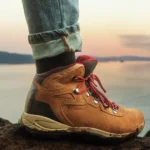
Greetings to all the spirited moms with a love for the great outdoors! Today we’re going to shine a spotlight on a fantastic piece of gear that could take your hiking experience to the next level: trekking poles.
While these ingenious inventions may appear simple, they pack some pretty powerful punch when it comes to functionality. If you’re still on the fence about incorporating them into your hiking arsenal, let’s delve deeper into why they might just become your new best friends on the trails!
Say Hello to Stability
Hiking comes with its very own fair share of challenges, from rough terrain to slippery slopes. Stability, therefore, is essential, and this is where trekking poles make their grand entrance.
Think of your trekking poles as additional limbs. On uneven paths or steep inclines, these extra ‘limbs’ can distribute your weight evenly, reducing the risk of falls and stumbles. Even the trickiest trails become more manageable, giving you the confidence to explore paths less traveled.
Moreover, for moms with toddlers in tow or carrying babies in backpack carriers, trekking poles offer additional balance and security. They essentially become an extension of your body, making your hike safer for both you and your little ones.
Keeping Up the Pace
Do you enjoy the invigorating feeling of maintaining a steady, brisk pace during your hikes? Trekking poles are about to become your ultimate companion.
Using the poles engages your upper body, helping propel you forward, and creating a steady rhythm. The regular movement of swinging the poles and striding can help you maintain a consistent pace, ensuring you cover more ground without exhausting your legs.
So whether you’re racing against time to get back home for dinner or striving to improve your overall fitness levels, trekking poles can be the wind beneath your wings!
Protect Your Knees and Joints
Motherhood and constant running around can be quite taxing on your body, especially your knees and joints. Add to that the impact of hiking, and it could potentially lead to discomfort or even injury. But fear not, trekking poles are here to save the day!
Hiking downhill generates a lot of force on your knees – it can be equivalent to up to five times your body weight. But when you use trekking poles, they can absorb a significant chunk of this impact (up to 25%), thereby reducing the strain on your knees and other joints.
So, bid adieu to sore muscles and aching joints post a hike. With trekking poles by your side, you can enjoy your outdoor adventures with lesser strain on your body!
Boost Your Workout
Who doesn’t love a bonus? Consider your trekking poles a ‘cheat code’ to elevate your hiking experience to a full-blown workout.
By using trekking poles, you’re actively engaging your upper body muscles, plus your arms, shoulders, and core. This gives you a total body workout, increasing the calories burned during your hike. So, you’re not only connecting with nature but also staying in shape. Talk about multitasking!

Trekking Pole Tips and Hacks
With a better understanding of the benefits of trekking poles, let’s shift our focus to how to make the most out of them:
- Size Matters: Trekking poles should be of the right height. An easy way to gauge this is to check your elbow angle when you grip the pole handle – it should be at 90 degrees when the pole tip is on the ground. This helps ensure optimal comfort and efficiency.
- Explore the Extras: Nowadays, trekking poles come with several additional features. Some offer shock absorbers for added joint protection, while others provide adjustable lengths for different terrains. When choosing poles, take into consideration your regular hiking environments and specific needs.
- Mind the Straps: The straps on your trekking poles are more than just accessories. They are designed to distribute the load to your wrists, reducing strain on your hands. It’s best to insert your hand from below into the strap and then grasp the grip.
- Mud and Snow Baskets: Depending on where you hike, these can be lifesavers. These attachments stop your poles from sinking into softer surfaces. Use the smaller baskets for muddy terrains and the larger ones for snowy conditions.
- Practice Makes Perfect: It may feel a bit awkward to use trekking poles at first. Start by integrating them into your shorter, local walks before embarking on your big hiking adventures.
Frequently Asked Questions (FAQs)
Q: Can trekking poles be used for any type of hike? Absolutely! Whether you’re on a gentle forest trail or challenging mountain terrain, trekking poles can provide stability, rhythm, and relief. They’re particularly beneficial for hikes involving significant elevation changes.
Q: How do I properly hold my trekking poles? First, slip your hand through the strap from the bottom. Then, hold the pole’s grip, letting the strap rest against your wrist. This way, you can maintain a pretty relaxed grip without the risk of dropping your poles.
Q: I have arthritis. Are trekking poles still useful? Yes, definitely! In fact, using trekking poles might help alleviate some discomfort caused by arthritis. By transferring some of the load off your knees and hips, you may find walking or hiking less painful.
Q: Can children use trekking poles? Indeed, they can. Just ensure the poles are height-adjustable to suit your child’s growing phase. Trekking poles can help instill a love for hiking early on while teaching kids about safety and stability on the trails.
Trekking poles are a phenomenal addition to any active mom’s hiking gear. They’re all about enhancing your outdoor experiences – providing stability, protecting your joints, maintaining a steady pace, and transforming hikes into full-body workouts. So on your next adventure, take along your trusty trekking poles and embrace the many benefits they offer. Happy hiking, moms!






